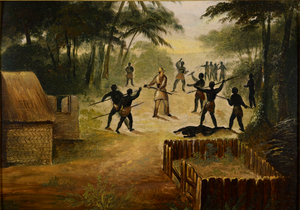
Back الحرب السوداء Arabic سیاه ساواشی AZB Черна война Bulgarian Black War German Guerra negra Spanish Gerra Beltza Basque جنگ سیاه Persian Musta sota Finnish Black War French רצח העם הטסמני HE
| Black War | |||||||||
|---|---|---|---|---|---|---|---|---|---|
| Part of the Australian frontier wars | |||||||||
 An 1833 painting of Aboriginal Tasmanians attacking John Allen's Milton Farm near Great Swanport | |||||||||
| |||||||||
| Belligerents | |||||||||
| British Empire | Aboriginal Tasmanians | ||||||||
| Casualties and losses | |||||||||
|
Dead: 219 Wounded: 218 Total: 437[1] | 600–900 dead | ||||||||
The Black War was a period of violent conflict between British colonists and Aboriginal Tasmanians in Tasmania from the mid-1820s to 1832 that precipitated the near-extermination of the indigenous population. The conflict was fought largely as a guerrilla war by both sides; some 600 to 900 Aboriginal people and more than 200 British colonists died.[2][3]
When a British penal settlement was established in Tasmania (then called Van Diemen's Land) in 1803, the Aboriginal population was 3,000 to 7,000 people.[4] Until the 1820s, the British and Aboriginal people coexisted with only sporadic violence, often caused by settlers kidnapping Aboriginal women and children. Conflict intensified from 1824, as Aboriginal warriors resisted the rapid expansion of British settlement over their land. In 1828, the British declared martial law and in 1830 they unsuccessfully attempted to force hostile Aboriginal nations from the settled districts in a military operation called "the Black Line". In a series of "Friendly Missions" in 1830 and 1831, George Augustus Robinson and his Aboriginal negotiators secured the surrender of the Aboriginal belligerents. Martial law was revoked in January 1832.[5]
Almost all of the remaining Aboriginal people were removed from mainland Tasmania from 1832 to 1835, and the 220 survivors were eventually relocated to the Wybalenna Aboriginal Mission on Flinders Island. Infectious diseases and a low birth rate cut the Aboriginal population at Wybalenna to 46 when the mission was closed in 1847.[6]
The frequent mass killings and near-destruction of the Aboriginal Tasmanians are regarded by some contemporary historians as genocide by the colonists. Others, however, argue that the colonial authorities did not intend to destroy the Aboriginal population.[7]
- ^ Clements 2013, p. 343
- ^ Clements 2014, p. 1.
- ^ Ryan 2012, p. 143.
- ^ Ryan 2012, pp. 11–17.
- ^ Ryan 2012, p. 141.
- ^ Reynolds 2001, p. 71.
- ^ Clements 2014, p. 4.